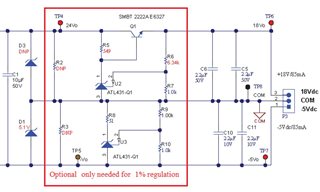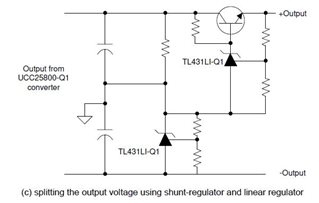Other Parts Discussed in Thread: TL431
Hi,
We would like to use the UCC25800-Q1 to build a Gate driver bias supply for SiC FET.
Requirements:
Input voltage: 22...26V (24V nominal)
Output voltage +15V and -4V
Output power: around 4W
Due to this requirements I made some measurements with the UCC25800EVM-037.
On this board the following Postregulator is implemented:
The datasheet of the UCC25800-Q1 proposes the following Postregulator circuit:
Questions:
a) What are the pros and cons of those different approaches?
b) Is it correct that unbalanced load current is a problem as soon as the difference reaches the maximum TL431 IKA current?
c) How was the circuit on the UCC25800EVM-037 designed? (e.g. Zener voltage of D1 or resistor value of R8 and R5?
d) Is it right that the output capacitors habe to be balanced (matched) to the output voltages for a gate driver supply application? (to have balanced output currents)
Any feedback is highly appreciated.
Thanks and best regards,
Patrick

